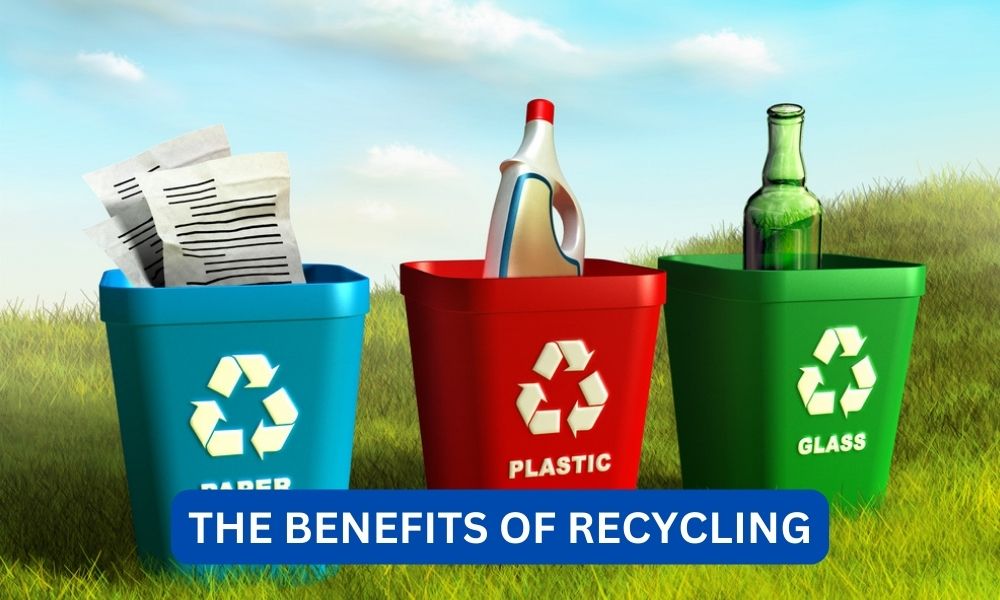Recycling has become an increasingly important topic in today’s society, as we continue to face environmental challenges such as pollution, climate change, and depletion of natural resources. Recycling is the process of converting waste materials into new products, reducing the need for raw materials and energy consumption. It is a simple yet effective way to contribute towards a more sustainable future. In this article, we will explore the various benefits of recycling and why it is crucial for us to incorporate it into our daily lives.
Contents
1. Reducing Landfill Waste
One of the most significant benefits of recycling is the reduction of landfill waste. Landfills are designated areas for the disposal of waste materials, and they are rapidly filling up due to the increasing amount of waste produced by humans. According to the Environmental Protection Agency (EPA), the United States generated 292.4 million tons of municipal solid waste in 2018, and only about 32.1% of that was recycled or composted. The rest ended up in landfills, where it takes years to decompose and can release harmful chemicals into the environment.
By recycling, we can divert a significant amount of waste from landfills, reducing the need for new landfills to be created. This not only helps to preserve land and natural habitats but also prevents the release of harmful gases such as methane, which contributes to climate change. Recycling also reduces the need for incineration, which can release toxic chemicals into the air and contribute to air pollution.
Read:What are the 7 woes in matthew 23?2. Conserving Natural Resources
Recycling also plays a crucial role in conserving natural resources. Many of the products we use in our daily lives, such as paper, plastic, and metal, are made from raw materials extracted from the earth. These resources are finite and can be depleted if we continue to consume them at an unsustainable rate. By recycling, we can reduce the demand for these raw materials and preserve them for future generations.
For example, recycling one ton of paper can save 17 trees, 7,000 gallons of water, and 463 gallons of oil. Similarly, recycling one ton of plastic can save 16.3 barrels of oil, 5,774 kWh of energy, and 30 cubic yards of landfill space. By recycling, we can also reduce the need for mining, logging, and drilling, which can have significant environmental impacts such as deforestation, soil erosion, and water pollution.
3. Energy Conservation
Recycling also helps to conserve energy, which is crucial in today’s world where energy consumption is a major contributor to climate change. The production of new products from raw materials requires a significant amount of energy, whereas recycling uses much less energy. For example, recycling aluminum cans can save up to 95% of the energy needed to produce new cans from raw materials.
Read:What’s a madame butterfly drink?Moreover, recycling also reduces the need for transportation of raw materials, which further saves energy and reduces carbon emissions. For instance, recycling one ton of plastic can save 2,000 gallons of gasoline, which is equivalent to taking 3.6 cars off the road for a year. By reducing our energy consumption, we can help to mitigate the effects of climate change and create a more sustainable future.
4. Economic Benefits
Recycling also has significant economic benefits. It creates jobs in the recycling industry, from collecting and sorting to processing and manufacturing. According to the EPA, recycling and reuse activities in the United States accounted for 757,000 jobs and $36.6 billion in wages in 2016. This not only helps to boost the economy but also provides employment opportunities for individuals in the community.
Moreover, recycling also reduces the cost of waste management for local governments and taxpayers. Landfills and incineration facilities are expensive to build and maintain, and the cost is often passed on to taxpayers. By recycling, we can reduce the amount of waste that needs to be disposed of, thus reducing the cost of waste management.
5. Reducing Pollution
Recycling also helps to reduce pollution, which is a significant environmental issue. When waste is disposed of in landfills, it can release harmful chemicals and greenhouse gases into the environment. These pollutants can contaminate soil, water, and air, and have adverse effects on human health and the environment.
Read:What a fucking day wine glass?For example, electronic waste (e-waste) contains toxic substances such as lead, mercury, and cadmium, which can leach into the soil and water when disposed of in landfills. By recycling e-waste, we can prevent these toxic substances from polluting the environment and harming human health. Recycling also reduces the need for incineration, which can release harmful pollutants into the air.
6. Promoting a Circular Economy
Recycling is a crucial component of a circular economy, which aims to minimize waste and maximize the use of resources. In a circular economy, products are designed to be reused, repaired, or recycled, rather than disposed of after a single use. By recycling, we can help to create a closed-loop system where materials are continuously reused, reducing the need for new resources to be extracted.
For example, many companies are now using recycled materials in their products, such as recycled plastic in water bottles or recycled paper in packaging. This not only reduces the demand for new resources but also creates a market for recycled materials, making recycling a more economically viable option.
Examples of Successful Recycling Programs
There are many successful recycling programs around the world that have made a significant impact on reducing waste and promoting sustainability. Here are a few examples:
1. Sweden
Sweden is known for its efficient waste management system, with only 1% of its waste ending up in landfills. The country has implemented a “pay-as-you-throw” system, where households are charged based on the amount of waste they produce. This has encouraged people to recycle and reduce their waste, as they can save money by producing less waste.
Moreover, Sweden also has a well-developed recycling infrastructure, with over 99% of its household waste being recycled or used for energy production. The country also imports waste from other countries to use in its waste-to-energy plants, which provide heat and electricity to homes and businesses.
2. Japan
Japan has one of the highest recycling rates in the world, with over 80% of its waste being recycled. The country has a strict waste management system, where households are required to sort their waste into different categories, such as burnable, non-burnable, and recyclable. This has made it easier for the government to collect and recycle waste effectively.
Moreover, Japan has also implemented a “3R” policy – reduce, reuse, and recycle – which encourages individuals and businesses to reduce their waste and promote a circular economy. The country also has a strong focus on education and awareness, with campaigns and programs to educate people about the importance of recycling and how to do it correctly.
3. San Francisco, USA
San Francisco has one of the most successful recycling programs in the United States, with a diversion rate of 80%. The city has implemented a mandatory recycling and composting program, where residents and businesses are required to separate their waste into three categories – recyclables, compostables, and landfill waste.
The city also offers incentives for recycling, such as discounts on waste collection fees for households that produce less waste. Moreover, San Francisco has also banned the use of plastic bags and Styrofoam containers, reducing the amount of waste that ends up in landfills.
Conclusion:
Recycling is a simple yet effective way to contribute towards a more sustainable future. It not only helps to reduce landfill waste and conserve natural resources but also has significant economic and environmental benefits. By recycling, we can reduce pollution, conserve energy, and promote a circular economy. It is crucial for individuals, businesses, and governments to work together to increase recycling rates and create a more sustainable world for future generations.
As Mahatma Gandhi once said, “The earth provides enough to satisfy every man’s needs, but not every man’s greed.” By recycling, we can reduce our impact on the environment and create a more sustainable future for all. So let’s all do our part and make recycling a part of our daily lives.








